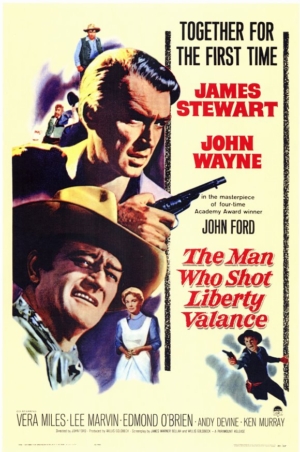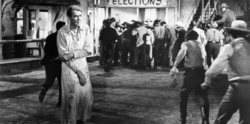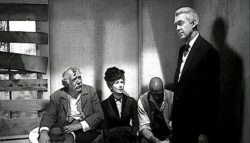The Man Who Shot Liberty Valance: Cultural Attitude of the Press
 With drama, comes curiosity. However, what happens when what we know isn’t what really happened? The Man Who Shot Liberty Valance speaks to historical inaccuracies and the success that comes from it. Ransom Stoddard is traveling when his stagecoach is taken over by Liberty Valance, a villainous threat to the small town. After an altercation that leaves Ransom injured, Tom, a strong local, comes to his rescue. With the help of a waitress, Hallie, and the restaurant owners, Ransom recovers and wants revenge. His law-abiding ways are uncommon in the town. Yet Ransom and Valance are caught in a gunfight. Liberty Valance surprisingly dies and the town assumes Ransom was the man who shot him. After receiving notoriety for saving the town, Tom tells Ransom that it was him who pulled the trigger. Knowing he was inexperienced with violence, Tom fired to save Ransom. Years later, Tom dies and the myth of Senator Stoddard saving the town continues to be told. The town labels him a celebrity whose career is as important as his name. The Man Who Shot Liberty Valance represents what we label as news based on the interests of someone’s success.
With drama, comes curiosity. However, what happens when what we know isn’t what really happened? The Man Who Shot Liberty Valance speaks to historical inaccuracies and the success that comes from it. Ransom Stoddard is traveling when his stagecoach is taken over by Liberty Valance, a villainous threat to the small town. After an altercation that leaves Ransom injured, Tom, a strong local, comes to his rescue. With the help of a waitress, Hallie, and the restaurant owners, Ransom recovers and wants revenge. His law-abiding ways are uncommon in the town. Yet Ransom and Valance are caught in a gunfight. Liberty Valance surprisingly dies and the town assumes Ransom was the man who shot him. After receiving notoriety for saving the town, Tom tells Ransom that it was him who pulled the trigger. Knowing he was inexperienced with violence, Tom fired to save Ransom. Years later, Tom dies and the myth of Senator Stoddard saving the town continues to be told. The town labels him a celebrity whose career is as important as his name. The Man Who Shot Liberty Valance represents what we label as news based on the interests of someone’s success.
What is most interesting about this film is the separation between contemporary and flashback. The contemporary scenes, like when Ransom and Hallie arrive in town, appear brightly lit and more progressive compared to the past. When the press becomes involved in Ransom’s business, it feels strange because the old town was very traditional in that your business wasn’t everyone’s business. Yet, in the present day, the reporter admits it’s his responsibility to uncover the reason Ransom and Hallie are in town. Regardless of Tom’s funeral being the reason for their visit, the news reporter is more concerned with knowing why they are there. Senator Ransom’s “celebrity status” trumps the intimacy of their visit. There seems to be a disconnect between genuine emotion and superficial vanity.

The film stylistically has Ransom and Hallie arriving and leaving the town by train. At first, we have no idea who they are or why they are there. When they arrive, they are welcomed by energetic and curious new journalists wanting to know about their visit. We assume, based on their surprise, the town rarely gets visitors with such importance. The train also appears to be a more modern form of transportation compared to when Ransom first approached the town, which helps remind the audience most of the film is a flashback. The young journalist overhears the Marshall welcome Ransom and Hallie into town. He asks Jason, a local train employee, who Ransom was and if he is important enough for a line in his column. Jason responds by saying “you can fill your newspaper with [Senator Stoddard and Hallie Stoddard], they are that important. The journalist runs to the phone and rings someone to tell the newspaper the Senator is in town.
While they don’t know why he’s in town, his physical attendance is enough to interest the reporters. What is meant to be a very solemn moment between those closest with Tom is interrupted. The editor introduces himself by first saying, “I don’t mean to intrude” when he is doing just that. It is in poor taste to want information about a senator’s arrival in a small town and worse when they demand it. In the past, Hallie was feeding people at the restaurant who weren’t paying out of the goodness of her heart. I do not believe if something tragic happened back then the town would be as heartless as the reporter is being. What is more interesting is why the reporter feels he is allowed the information at this specific moment. I think this is a testimony of how “celebrity” culture has become something of a necessity. Reporting on a personality, like a senator, is considered the news that needs to be reported on as soon as possible. This specific reporter says he has a “responsibility” to get the information on who Tom was. This responsibility in today’s culture is disguised as the large audience and commercial success companies receive from writing on someone’s personal life.

The commercial and capitalistic themes are shown in the last scene between Ransom and the news reporters. After he walks out of his friends’ funeral, he tells the entire story of Tom and his relationship with him. The reporter recites all of Ransom’s governmental accomplishments that grew from the lie of him saving the town. He then grabs the notes and rips them up, symbolizing how irrelevant the truth about Ransom is. “This is the West. When the legend becomes fact, print the legend”, says the reporter. This isn’t just about the West. It is about society and the media’s impact. If the lie is more interesting than the truth, it’s more beneficial to print the myth.
If released today, I believe the reporters would be less respectful towards Ransom’s accomplishments. They would want a scandal they could report and investigate. The Man Who Shot Liberty Valance was released in 1962 and celebrity culture obsession, I would argue, was still relatively premature. However, it did occur. Granted it was nothing like today which is why the response to the press is unique in the film. People joke about how reporters will do anything for a story. The film demonstrates how narcissistic and insensitive the press can be towards a human being and their story.
What do you think? Leave a comment.











I saw this film in the movie theater when it was released as a boy. I was surprised it was black and white. I must say i didn’t really get it at age 10! This movie is one of the greatest of all time.
I toggle between this film and “The Searchers” as the best of all Westerns. Call them 1 and 1A. Two movies as different as two Westerns can be that present two entirely different sides of John Wayne. How do you choose? What tips the scales for me in the direction of “Liberty Valance” is Wayne’s brilliantly nuanced portrayal of Tom Doniphon. This is not the uber-confident, somewhat one dimensional, get out of the way Wayne you see in “The Searchers” and most of his other Westerns. To see the inherent toughness and bravado we’ve come to expect mixed with elements of doubt and uncertainty is what separates “Valance” from the rest of the pack.
One of my favorite scenes from this classic is when the town doctor is called upon by Strother Martin to tend to the already dead Liberty Valance now lying in the street. The doctor requests a bottle of bourbon leading the audience to believe he’s about to tend to the wound. Instead the doctor takes a draw from the bottle, looks down at the body, and quickly declares “he’s dead!”
that was great, i laughed at that scene
Lee Marvin put extra layers of vile in his performance. A genius.
great read, very informative!
This movie does a great job of giving us historical info without it seeming like a history lecture. It really is good storytelling.
I can’t help but think that movies like “The DaVinci Code” and “Angels and Demons” would be better if they used this movie as a model.
This is a good movie with an absorbing plot, but I found it difficult to buy Stewart in the lead role. He was much too old to play this character.
Having just watched it, I was struck by the poignancy of Tom’s (Wayne’s) heartache at losing Hallie, but he was nonetheless honorable to the last, helping the lawyer out of selfless love for her. And the sadness of everyone at losing Tom when he died. He was the quiet hero of the film. Also great is the humor in the supporting characters (typical of Ford), including a lot of drinking of whiskey. And it’s a great history lesson as well on how the west became civilized.
I have just seen The Man Who Shot Liberty Valance again and I noticed very much the Ann Rutledge theme music that Ford used before in Young Mr Lincoln. To me it is a poignant expression of lost love and it underlines the emotional meaning of the film..
If this had been John Ford’s only Western, no one today would remember his name.
I had never seen this film before. I’m not sure why because I like the stars and well-made Westerns.
Sadness and melancholy at the end of the film were something totally new to the genre.
It is incomprehensible to me that such a masterpiece as this only received one Academy Award nomination.
A timeless classic.
This film is worth watching just to see the drunken antics of Mr. Peabody!
I just watched this movie again on the Grit channel. I remember watching it when I was 7 or 8 when it first showed in the theater in my small hometown.
Superb.
The film gets some flak for the casting of James Stewart and John Wayne, both of whom are not too believable as the young versions of themselves. Both men were in their mid-fifties when the film was made, and the look their age. But I don’t mind the casting, because the young Ransom Stoddard is simply how Stoddard remembers himself, not as he actually was. So it fits. As the famous line near the end of the film goes, “When the legend becomes fact, print the legend.”
“The Man Who Shot Liberty Valance” feels like an end-of-an-era type of Western. John Wayne was seen as a cultural hero of an American myth that never was. To me, this movie represented the unveiling of that myth. All previous John Wayne movies, for the most part, had him as the proud hero who won the girl in the end. “The Man Who Shot Liberty Valance” is the ultimate subversion of all this. With John Ford behind the helm, the subversion is even more pronounced. The idea of the Western, where a man could “make his own code and live by it” to quote Joan Didion, was mere wishful dreaming. At the end of the 60s, the guise of this American Dream was disappearing. American audiences simply no longer believed it or began to doubt it. This movie was the final reveal. The Western was nothing but a myth built upon exaggerated truths that will die with the men who spun them.
“When the legend becomes fact, print the legend” John Ford might have thought he made a movie about how the public saw the west but his movie can apply to politics. Repeat something enough and it becomes real and challenging it becomes difficult. I always thought it was interesting that Jimmy Stewart’s character goes into politics. This is an excellent movie, one I frequently discuss in my politics classes. Students can gain insight into political beliefs not always grounded in facts from discussing the movie.
A good article. I discuss this movie in every politics course I teach. I even discussed it in a chapter I wrote.